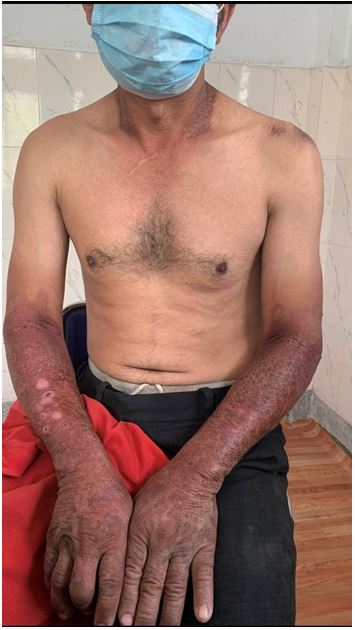Clinical Image - Volume 3 - Issue 5
Pellagra: A forgotten sporadic clinical entity in primary health care
Shambhu Khanal1*; Sushmita Bhandari2; Savita Aryal3; Buddha Rayamajhi4
1Department of Internal Medicine, Lumbini Provincial Hospital, Nepal.
2Department of Dermatology, Fatima Jinnah Medical University, Lahore, Pakistan.
3Department of Otorhinolaryngology, Universal College of Medical sciences, Nepal.
4Department of Dermatology, Institute of Medicine Tribhuvan University, Nepal.
Received Date : July 19, 2023
Accepted Date : Aug 29, 2023
Published Date: Sep 05, 2023
Copyright: © Shambhu Khanal 2023
*Corresponding Author : Shambhu Khanal, Department of Internal Medicine, Lumbini Provincial Hospital, Nepal.
Email: shambhukhanal19@gmail.com
DOI: Doi.org/10.55920/2771-019X/1540
Clinical Image
A 45- year- old male from an urban community, laborer, heavy alcohol consumer, exclusively on rice diet presented to outpatient department in primary health care centre with chronic diarrhea for three months. He was treated multiple times with antibiotics with no improvement. There was no family history of similar illness. He had normal vital signs and mental state. On general examination, he had typical sharply marginated symmetrical scaly hyperpigmented plaques in sun exposed areas of his forearms and hands and necklace pattern of erythematous scaly plaque around the neck popularly known as Casal’s necklace as described in figure 1. The clinical background and dermatological pattern was sufficient enough to initiate treatment of pellagra with oral Niacin 300 mg daily and vitamin B complex. He had dramatic improvement in his episodes of diarrhea. He had gradual recovery in dermatitis.
Pellagra is a sporadic and often ignored clinical entity which is classically described as constellation of dermatitis, diarrhea, dementia and death [1]. Niacin deficiency is a clinical consideration in chronic alcoholics, malnourished individuals, malabsorptive disorders, exclusive maize diet and patients on hemodialysis [2,3]. Being a fatal but treatable nutritional disorder, the high index of suspicion can identify the disease early in community. Only 15-20 mg of niacin in diet daily is sufficient to prevent pellagra in all age groups. The daily recommended dose for treatment of pellagra is 300 mg of nicotinamide in divided doses. Besides traditional concept of pellagra in maize eating population, pellagra can be seen in exclusively rice eating population as seen in Bhutanese refugees from Nepal in 1994. Fortified blended diet with niacin almost eradicate the disease [3].
Acknowledgements: We would like to thank everyone involved during treatment.
Conflict of interest: No conflict of interest.
Funding: The work has no funding source.
Ethical approval: The consent from the patient deemed to be enough.
Consent: Written informed consent taken from the patient.
Figure 1: Pellagra dermatitis on dorsum of forearms and Casal’s necklace pattern pellagra dermatitis on neck.
References
- Martino GP, Agostini A, Girotti S, Bitti G, Ciarrocchi A, Angelici S. Pellagra: a Still Present Disease. SN Compr Clin Med. 2021;3(8):1801-1803. doi:10.1007/s42399-021-00949-6
- MacDonald A, Forsyth A. Nutritional deficiencies and the skin. Clin Exp Dermatol. 2005;30(4):388-390. doi:10.1111/j.13652230.2005.01787.x
- World Health Organization: Pellagra and its prevention... - Google Scholar. Accessed January 13, 2023.


